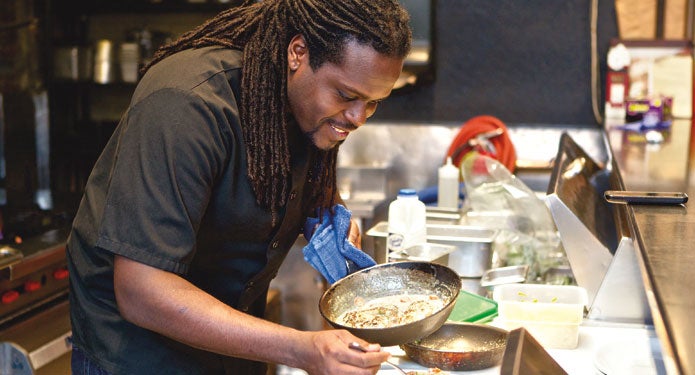As the labour market tightens, it’s a good time to work on easing the financial impact of turnover and hiring.
Increasing margin pressure and a heightened battle for market share are two of the most significant issues facing restaurant operators today. Both factors are driven partly by labour conditions.
Factors such as rising wages have tightened the labour pool. At the start of 2017, Restaurants Canada reported nearly half (48%) of table-service restaurants reported a shortage of skilled labour. With more people than ever retiring, labour shortages are expected to grow as competition heats up for young workers.
Competition for diners also is a concern. Operators compete with each other as they see an emerging demand for delivery services and at-home meal providers like Home Meal Replacement and Chef’s Plate. These factors make it important for full-service restaurants to concentrate on service customers will value.
“Customers want enjoyment and attentive service, but the bar on service has gone way down because operators can’t train properly when they have to spend so much time hiring new people to fill their shifts,” Randy Bubb says. The Gordon Food Service Delta, British Columbia Food Service Adviser explains how operators must make their restaurant a well-run eatery where people are associates or teammates, not just staffers doing a job. “People buy in when you have the right attitude.”
Multiple solutions for a multifaceted problem
While there is no single solution to improve profitability, you can improve employee acquisition and turnover, thereby upgrading your value to consumers. The following are necessities of any approach.
Benchmarking. Determine the real financial impact of labour/staffing issues. This will help determine how you’re performing against similar operators and reveal ways to reduce costs. Restaurants Canada’s annual Foodservice Operations Report provides general industry standards (such as labour accounting for roughly 31% of operating revenues in the average commercial foodservice business). It enables you to gauge your performance. Buying this report annually will help set goals and track progress.
Hiring and recruiting. Before you begin the hiring process, define the “value proposition” you offer employees.
“Think of potential employees the way you think of customers,” advises Lisa McKiernan, Manager of Talent Acquisition for Gordon Food Service. Create a brand that promises employees a unique working environment. “Recognize that you are being interviewed by candidates who have options.”
Those needs are different for everyone. For example, millennials won’t automatically grant you their devotion. You need to earn their loyalty—just as with consumers—by carrying through on the promises you’ve made them.
One way to do this is involve employees more fully in your operation. “They want more than a place to work, they want a place that understands them,” says Murray Penner, Gordon Food Service Director of Marketing and Procurement in Delta, British Columbia.
If you can offer that, let candidates know it in the interview—tell them the good and the bad. For instance, “You may not make as much in tips here as you would the steakhouse down the street, but we have a clear path to leadership, if that’s what you want.”
This honesty will help ensure that you hire the right people—ones who understand and support your vision. “As diners, we know what staffing excellence looks like,” Penner says. “It doesn’t happen by accident—it’s the result of finding the people who match your brand promise with consumers.”
The hiring process. The hiring process has evolved radically. Emboldened by technology, people are searching for jobs and making employment decisions quickly. Operators must provide multiple technology touch points to reach job candidates.
Internet job postings, online applications and pre-vetting solutions that identify strong candidates have changed the process for employees and employers alike. These technologies can position you as an employer of choice while reducing the time and cost of hiring.
Retention/motivation. Retaining employees in a competitive market is challenging. Higher wages can drive employee defections. In some cases, Penner says, a chef who leaves may take the line cooks and even dish washers. But you can counteract the lure of higher pay by continuing to deliver on your value proposition.
Here are four retention strategies worth considering:
- Rewards for performance.
- Rewards for tenure.
- Creating networking teams to engage in problem-solving.
- Leadership planning and execution.
For independent operators, turnover is a constant battle. But Penner notes that investment in retaining the right people more than pays for itself in reducing turnover costs.
The leadership factor. No strategy will succeed without strong leaders. Provide both leadership candidates and current leaders with training, including an understanding of your target employees. Your leaders’ ability to communicate your vision to employees directly affects the employee experience and, in turn, the guest experience.
Every operator has the vision and the dream, but few have sophisticated training programs,” Bubb says. Training employees directly instead of letting them learn from one another is one way to make customer service stand out. “People still go to restaurants for the occasion, and the right training is important to a well-run eatery.”
The key to resolving staffing issues isn’t just identifying problems and solutions. It’s the ability to implement strategies your leadership can deliver against. Make that happen, and you’re on your way to increased profitability and guest counts.
The labour shortage squeeze
An increase in job openings raises the threat of turnover. It a sign the labour market is tightening. Operators, pressured to increase wages to attract workers, are feeling the pain—72% said labour costs are their top concern, according to Restaurants Canada’s Restaurant Outlook Survey.










